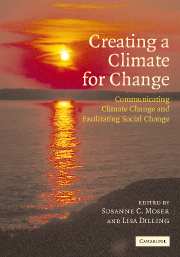Book contents
- Frontmatter
- Contents
- Preface
- Foreword
- List of contributors
- List of tables
- List of figures
- List of text boxes
- Introduction
- Part I Communicating climate change
- 1 Weather or climate change?
- 2 Communicating the risks of global warming: American risk perceptions, affective images, and interpretive communities
- 3 More bad news: the risk of neglecting emotional responses to climate change information
- 4 Public scares: changing the issue culture
- 5 The challenge of trying to make a difference using media messages
- 6 Listening to the audience: San Diego hones its communication strategy by soliciting residents' views
- 7 The climate-justice link: communicating risk with low-income and minority audiences
- 8 Postcards from the (not so) frozen North: talking about climate change in Alaska
- 9 Climate change: a moral issue
- 10 Einstein, Roosevelt, and the atom bomb: lessons learned for scientists communicating climate change
- 11 Across the great divide: supporting scientists as effective messengers in the public sphere
- 12 Dealing with climate change contrarians
- 13 A role for dialogue in communication about climate change
- 14 Information is not enough
- Part II Facilitating social change
- Part III Creating a climate for change
- About the authors
- Index
- References
2 - Communicating the risks of global warming: American risk perceptions, affective images, and interpretive communities
Published online by Cambridge University Press: 20 August 2009
- Frontmatter
- Contents
- Preface
- Foreword
- List of contributors
- List of tables
- List of figures
- List of text boxes
- Introduction
- Part I Communicating climate change
- 1 Weather or climate change?
- 2 Communicating the risks of global warming: American risk perceptions, affective images, and interpretive communities
- 3 More bad news: the risk of neglecting emotional responses to climate change information
- 4 Public scares: changing the issue culture
- 5 The challenge of trying to make a difference using media messages
- 6 Listening to the audience: San Diego hones its communication strategy by soliciting residents' views
- 7 The climate-justice link: communicating risk with low-income and minority audiences
- 8 Postcards from the (not so) frozen North: talking about climate change in Alaska
- 9 Climate change: a moral issue
- 10 Einstein, Roosevelt, and the atom bomb: lessons learned for scientists communicating climate change
- 11 Across the great divide: supporting scientists as effective messengers in the public sphere
- 12 Dealing with climate change contrarians
- 13 A role for dialogue in communication about climate change
- 14 Information is not enough
- Part II Facilitating social change
- Part III Creating a climate for change
- About the authors
- Index
- References
Summary
Introduction
Large majorities of Americans believe that global warming is real and consider it a serious problem, yet global warming remains a low priority relative to other national and environmental issues and lacks a sense of urgency. To understand this lack of urgency, the study on which this chapter is based examined the risk perceptions and connotative meanings of global warming in the American mind and found that Americans perceive climate change as a moderate risk that will predominantly impact geographically and temporally distant people and places. This research also identified several distinct interpretive communities of climate change: segments of the public that conceptualize and respond to the issue in very different ways. The chapter concludes with five strategies to communicate about global warming in ways that either resonate with the values and predispositions of particular audiences or that directly challenge fundamental misconceptions.
Public risk perceptions are critical components of the socio-political context within which policy-makers operate. Public risk perceptions can fundamentally compel or constrain political, economic, and social action to address particular risks. For example, public support or opposition to climate policies (e.g., treaties, regulations, taxes, subsidies) will be greatly influenced by public perceptions of the risks and dangers of climate change.
In this context, American public risk perceptions of climate change are critical for at least two reasons.
- Type
- Chapter
- Information
- Creating a Climate for ChangeCommunicating Climate Change and Facilitating Social Change, pp. 44 - 63Publisher: Cambridge University PressPrint publication year: 2007
References
- 77
- Cited by



